Ijraset Journal For Research in Applied Science and Engineering Technology
- Home / Ijraset
- On This Page
- Abstract
- Introduction
- Conclusion
- References
- Copyright
Plastic Crushing Machine
Authors: Ramesh K, Suriyaprakash L, Nareshkumar S, Sijo K
DOI Link: https://doi.org/10.22214/ijraset.2024.62484
Certificate: View Certificate
Abstract
A plastic crushing machine plays a crucial role in the recycling process by reducing plastic waste into smaller, manageable pieces. These machines are designed to process various types of plastic materials such as PET bottlesHDPE containers and PVC pipes,contributing to the mitigation of environmental pollution and resource conservation. This plastic waste is very difficult to store as it has large volume. Hence breaking down the plastic waste into ery small piece can help the problem of storage. This will reduce the burial and dumping of waste in earth. This project is based on electromechanical system.This project consist of electronic and Mechanical part mainly electric AC geared motor of 80 rpm,crushing drum flange bearing, v belt ,two gears of 130mm, that consist of micro controller. Two crushing drum are will rotate in opposite direction to squeeze the bottle and those two drums are driven by a single motor. In order to perform high thickness plastic material we have to adopt external gear meshing arrangement and a belt driven pulley from the motor. The machine is provided with two opening at the topside to insert the bottle and tin. when we insert the bottle it is detected by IR senSor or Proximity sensor. The bottle will fall on crushing drum the bottle gets squeezed between the two rollers.This crushed bottle will fall on the bin which is placed below the rollers. The main consideration for this design is cost effective and efficient. In conclusion,plastic crushing machines play a vital role in the recycling process,promoting environmental sustainability by transforming plastic waste into valuable raw materials.
Introduction
I. INTRODUCTION
A. Background Information of the Study
Plastic is a synthetic material made from a wide range of organic polymers such as polyethylene terephthalate (PET), high density polyethylene (HDPE), Polyvinyl chloride (PVC) and low-density polyethylene (LDPE) that can be moulded into a rigid or slightly elastic form. Plastic materials produced from oil by a chemical process are nonbiodegradable,
light in weight and do not break easily. Any property of a large number of synthetic polymers materials usually organic that have a polymeric structure and can be moulded when soft and then set, such materials are subspecies of a class of materials known as polymers. These are composed of large molecules formed by joining many, often thousands of smaller molecules (monomers) together. Other kind of polymers is fine, film, elastomers (rubber) and biopolymers.
The plastic industry, owing to its use in a wide variety of sectors, such as the automotive, construction, electronics, healthcare, textiles, drink industry, etc., is amongst the fastest growing markets. (RRN Bhattacharya, 2018). As the world’s population continues to grow by leaps and bound, so does the amount of plastic waste that people produce. On-the-go
lifestyles require easily disposable products, such as soda cans or bottles of water and soft drink, but the accumulation of these products has led to increasing amounts of plastic pollution around the world. As plastic is composed of major toxic pollutants, it has the potential to cause great harm to the air, water and land. (Amandeep, 2019).
Plastic pollution is when plastic has gathered in an area and has begun to negatively impact the natural environment and create problems for plants, wildlife and even human population. Often, this includes killing plant life and posing dangers to local animals. Plastic is an incredibly useful material, but it is also made from toxic compounds known to cause illness, and because it is meant for durability, it is not biodegradable. (Amandeep., 2019). Plastic waste is a constituent of the solid waste stream of which polyethylene terephthalate (PET) is a part. PET is used to produce plastic bottle and several other plastic products. Most bottles produced by PET are transparent in nature and are used for packaging water, soda etc. Plastic are non- bio degradable. It prevents or reduces the seepage of water into the soil. They clog/block the domestic pipelines and sewage lines. Direct burning of plastic leads to the emission of toxic fumes and gases, which in turn affect human health. Emission of carbon dioxide during burning of waste plastics causes rise in earth temperature i.e. global warming. Better industrial practices have led to minimizing exposure of plant workers to harmful fumes. For example, there have been problems in the past resulting from worker being exposed to toxic vinyl chloride vapour during the production of polyvinyl chloride. Many chemical ingredients of plastics are highly carcinogenic.
According to Bhattacharya ( the sustainable alternatives that could be considered to deal with plastic one of ,(2018 and poly lactic acid as raw materials for ,cellulose ,based and biodegradable plastic which utilizes starch-waste is to develop bio te-shortrm use products. However, these are more expensive and are presently at a lab scale, which needs to be up scaled.
It was further reported that incentive-/subsidy-based strategies for product development and research would assist in facilitating this up scaling into biodegradable plastics. Applications of bio-based products extend to the manufacturing o green packaging, disposable cutlery, agricultural mulch films, and manufacturing of superabsorbent materials, that can be used for a sustained release of pesticide/fertilizer in the agricultural sector. Further, these can also be used as eco-friendly alternatives for the removal of toxic dyes and heavy-metal contaminants from water bodies. (Bhattacharya, (2018
Plastic bottles are made from petroleum product known as polyethylene terephthalate (PET) and they require huge amount of fossils fuels to both make and transport them. It is harder to recycle plastic bottles than one thinks. Some plastic bottles consumed throughout the world, most of them are not recycled because only certain types of plastic bottle can be recycled by certain municipalities. This simply means that more resources are being used to meet the increasing demand for plastic. Thus, more waste is generated in this line, and to reduce some of these problems, plastic crushing machine was designed, fabricated and tested in the department of Agricultural and Bio Environmental Engineering technology, Federal Polytechnic Ilaro, Ogun State, Nigeria, to recycle plastic waste constituting menace around themetropolis.
Nitulet al (2015) studied the overview of recycle of various types of plastics. The report reveals that plastics are generally categorized into two types namely, recyclable and non-recyclable types. The recyclable plastics are PET, HDPE, LDPE, PVC, etc. while non-recyclable is plastic Bakelite, Nylon, etc. Sorting, Cleaning, Shredding, crushing and extrusion are the general steps which are involved in recycling plastics. This research endeavour focuses on one of major processes involved in recycling plastic, plastic crushing.
Plastic crusher is a machine that reduces used plastic bottles to smaller particle sizes to enhance its portability, easiness and readiness for use into another new product. Plastic crusher designed and constructed comprises of four major components namely; the feeding unit, the crushing chamber unit, the power unit and the machine frame.
II. METHODOLOGY
- To understand the shredder machine, the main or most important part is blade. Blade design is very important part in shredder machine.
- The design of the blade is done by using autocad and Solidworks 2018.
- The designing is further classified as different components are designed separately according to load calculations.
- After designing each component they assembled.
- This is about CAD modelling.
- Once Cad modelling is done the next step is material selection for the components.
- Depending on the prototype we designed the actual manufacturing will start
III. 3D VIEW
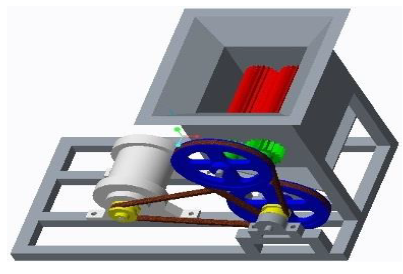
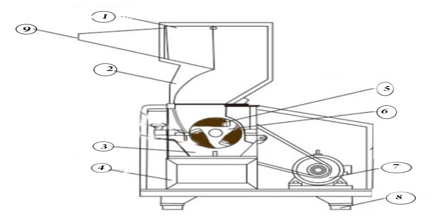
1.Feeding Bin 2. Deadening 3. screen shelf 4. Supporting base
5. Rotating Blades 6. Blade holder 7. Motor 8. Level pad
9.IR sensor (opening unit )
IV. LITERATURE SURVEY
Yeshwant M. Sonkhaskar, Amit Choubey, Amritpal Bhamra, Raghav Singhal, Anurag Sahu and et al., Has been explained about design of a Plastic Bottle Crusher which would help to crush the used Plastic bottles and would thereby help in waste managementand disposal. This project aims to design a portable Plastic Bottle crusher that could be installed anywhere and would aid crush of used bottles.
Dr Muhammad Maqbool Sadiq, Muhammad Rafique Khattak and et al., Plastic waste is silent threat to the environment and their disposal is a serious issue for waste managers. Now a day society does not have any alternative to plastic products like plastic bags, plastic bottles, and plastic sheets etc. In spite of all efforts made to limit its use but unfortunately its utility is increasing day by day. To circumvent this issue many efforts were made in the past to reuse the plastic waste but no significant results were achieved.
Zainab Z. Ismail et al. They have conducted comprehensive study based on large number of experiments and tests in order to determine the feasibility of reusing plastic sand as partial replacement of fine aggregate in concrete.
Youcef Ghernouti et al. The study present the partial replacement of fine aggregate in concrete by using plastic fine aggregate obtained from the crushing of waste plastic bags. Plastic bags waste was heated followed by cooling of liquid waste which was then cooled and crushed to obtained plastic sand having.
Yeshwant M. Sonkhaskar, Amit Choubey, AmritpalBhamra, Raghav Singhal, Anurag Sahu Has been explained about design of a Plastic Bottle Crusher which would help to crush the used Plastic bottles and would thereby help in waste management and disposal. This project aims to design a portable Plastic Bottle crusher that could be installed anywhere and would aid crush of used bottles[7].
Dr Muhammad Maqbool Sadiq, Muhammad Rafique Khattak, Plastic waste is silent threat to the environment and their disposal is a serious issue for waste managers. Now a day society does not have any alternative to plastic products like plastic bags, plastic bottles, andplastic sheets etc. In spite of all
efforts made to limit its use but unfortunately its utility isincreasing day by day. To circumvent this issue many efforts were made in the past to reuse the plastic waste but no significant results were achieved[8].
Vishal N. Kshirsagar describes about the experimentation ofcan or plastic bottle crusher machine and analysis of mechanism used in machine. Hence in this the knowledge of analysis is necessary, and by analysis of various parts the quality and life of machine can be increased and improved. Overall, for experimentation this machine involves processes like design, fabrication, analysis and assembling of different components etc. From this the knowledge of all the parameters like design, fabrication and analysis etc. will get increase but most important the knowledge of analysis, the use of Ansys- Workbench Software is increasing day by day to determine the parameters like stress, strain, deflection etc. for safe design and long durability [9].
Dr. Fauzia Siddiqui - The different components designed along the blade are frame/stand, shaft, washers, gears, pully etc. thus the designing phase is briefly classified as the machine construction, cutting system and the transmission system.
The total protect depends upon various parameters such as total knowledge about the system, design of a single blade and its arrangement of the main shaft, reduction in rotation.
Atadious David and Oyejide Oluwaymi Joel - Shredding machine is designed to reduce large solid material objects into a smaller volume, or smaller pieces. Shredding machines are usually used to reduce the size and shape of materials so they can be efficiently used for the purpose intended to. Collected plastics wastes were shredded with the machine and the results obtained reveal that the machine performance is satisfactory.
P.K.Farayibi. - Analysis of Plastic recycling machine design for production of thin filament coil. The conceptual design is considered fit for fabrication based on the design analysis and evaluation, using locally available and cheap material.
Dr. Jassim M. Abdulkarim Jaff, Darewan A. Abdulrahman - I includes plastic collection, manul sorting, chipping, washing pelleting. The large particles of plastic need to be broken down into small pieces to reduce storage and transportation space requirement.
Karolina Glogowska, Jakub Rozpedowski - During the shredding process, the following parameter were analysed : electricity consumption, temperature inside the shredding chamber and the temperature of the obtained recyclate. The study indicates the importance of the possibility to shape the workspace of the shredder and the energy relation of the process.
V. RESULTS AND DISCUSSIONS
A. Simulation
As we were instructed to solely focus on the functionality of blade, it was the only part we focused for simulation. 3D modeling of blade was imported to ANSYS. The analysis considered only static stresses and strain. No vibration or dynamic analysis was considered
Following process were carried out for simulation of blade:
B. Meshing
Meshing is one of the fundamental parts of any engineering simulation process where complex geometries are divided into simple elements which can be used as local approximations of the larger domain. The mesh influences the accuracy, convergence, and the speed of the simulations.
For our simulation automatic meshing was conducted with a body sizing of 2mm. Figure 1 illustrates the blade after meshing.
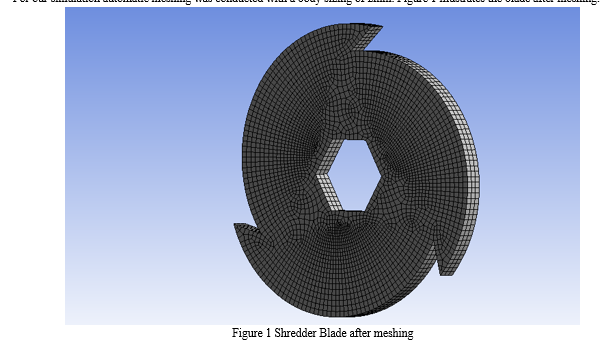
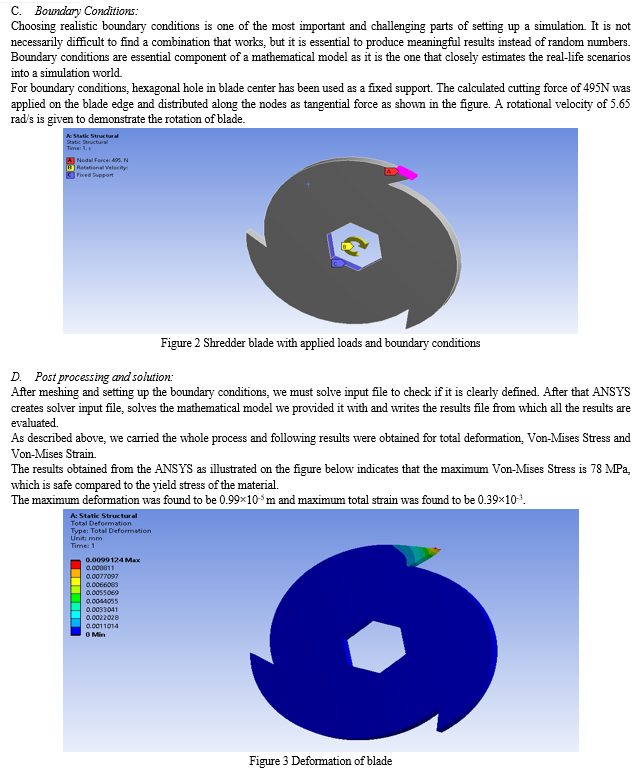
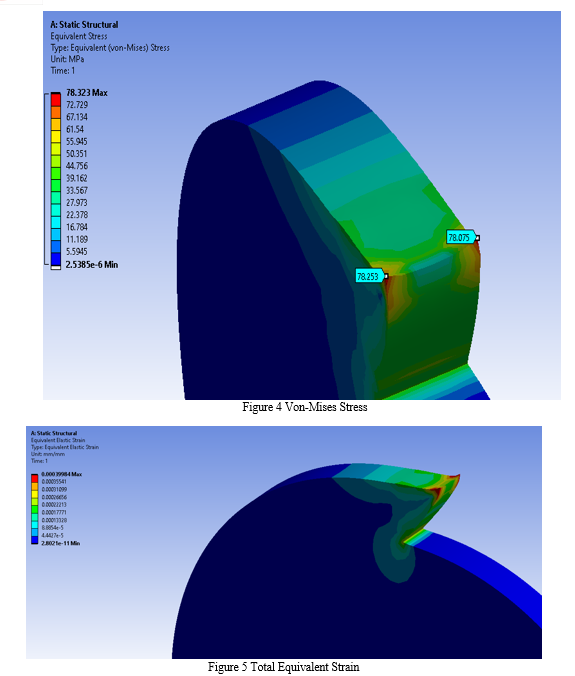
VI. WORKING
Initially the power supply is supplied to the electric motor by means of an external power source. The motor is controlled by a switch for the forward and reverse rotation of blades.It is done by the controlling of the Double Pole Double Throw switches. The switches are made in such a way to operate in forward as well as in reverse directions of the motor.Now the motor is switched on to the forward rotation and the power is transferred to the smaller pulley by means of the shaft coupled to it.
Then the smaller pulley drives the larger pulley which is connected with the belt. Again the larger pulley is coupled with another smaller pulley by means of a pillow block. The smaller pulley is then connected with the larger pulley with the help of the belt. The larger pulley is finally coupled with the main shaft in which the shredder blades are arranged. Gear arrangement is provided in between the larger pulley and the shaft for the opposite rotation of another shaft. Due to the smaller to larger pulley power transformation, the torque produced will be more from the larger pulley shaft than the
smaller pulley and also the speed will be reduced for smoother operation. The larger pulley is directly connected to the blade shaft. Due to that it starts to rotate in preferred direction. Now the plastic objects are feuded manually through the hopper at the top. When the plastic objects came into contact with the blades, it started to get crushed and shredded due to the crushing and shear stress acted upon them by the shredder blades. Finally, the shredded pieces of plastics will come down below the blades and it is collected in the collecting basket. The plastic which larger in volume before the shredding process is now reduced to very small pieces. The main objective behind the plastic shredder is to reduce the volume acquired by the plastic waste during loading it to the recycling process.
Conclusion
The plastic crusher is widely used in industries for plastic waste management. By using this plastic crushing machine, the overall costing of recycling process is reduced and labour work becomes less. To recycle waste plastic into other forms of plastics, the following machines are involved: Plastic crusher/shredder, extruder, granulating machine, washing machine, bale breaker, plastic melting and moulding machine etc. This technical brief focused on plastic crusher. The following are the conclusions from the evaluation work carried out on the machine: The plastic crusher is not a suitable machine for PET bottle recycling. The screen size used for the crusher design is small since materials above 8mm cannot flow easily through it. This in turn affects the feeding rate of plastic into the machine. When the machine is in operation, all parts are set in motion due to vibration of major parts like the transmission shaft. The vibration of parts brings about spill of materials under process out of the machine through hopper. Lid can be provided for the hopper to prevent material flow out of the machine. The plastic crusher can only be used for small scale recycling of plastic. The efficiencies of various type of polymers processed are 90% for HDPE, 68%for LDPE, 45% for PVC and 10% for PET bottles. Direct implication from this analysis is that the machine is not suitable for crushing PET bottles. Shredding machine should rather be used for materials of that nature by processors in the industry.
References
[1] Ajav E.A., Okusanya M.A. and Obi O.F. (2018). Jatropha Oil Extraction Optimization through Varied [2] Processing Conditions Using Mechanical Process. International Journal of Innovative Research & Development.Doi No.: 10.24940/Ijird/2018/V7/I9/Sep18058. Page 227 – 241, accessed June, 2020. [3] Akmal Bin Uzir, Khairuddin Bin Ishak, Norhafizah Akmal Binti Sukri [2014] The design & built of crusher machine plastic bottles, Volume -1, pg.no.184-189, 2014 [4] Amandeep Aggrawal (May, 2019). What are we doing to stop plastic menace. Down to earth. (www.downtoearth.org, accessed September, 2019). [5] Eric Beckman. (2018). The worid`s plastic problems in number. www.weform.org. [6] International Journal of Scientific and Engineering Research, Volume 7, Issue 5, May- 2016 ISSN 2229-5518 [7] Haslehurst, M. (1981). Manufacturing Technology (3rd edition). Academic and Medical Publishing Division of Hodder and Stronghton, Bedford Square, London. [8] International Journal of Engineering Technology Science and Research IJETSR www.ijetsr.com ISSN 2394 – 3386 Volume 4, Issue 10 October 201 [9] Jambeck JR, Geyer R, Wilcox C, Siegler TR, Perryman M, et al. (2015) Plastic waste inputs from land into the ocean. Science 347: 768-771. [10] Knox, Andrew (February 2005). ‘An Overview of Incineration and EFW Technology as Applied to the Management of Municipal Solid Waste (MSW)’ (PDF). University of Western Ontario. Archived from the original (PDF) on 5 December 2008. [11] NitulLimbasia, Rashmita Thummar. Amita Upadhyay [2015] Recycling of plastic waste-An overview e-ISSN:2394-3343, volume-2, issue2, pg.no.43-45, 2015. [12] P. Vindis, B. Mursec, C. Rozman, M. Janzekovic, F. Cus, Biogas production with the use of mini digester, Journal of Achievements in Materials and Manufacturing Engineering 28/1 (2008) P. 99- [13] RRN Sailaja Bhathachanya, Kaushik Chandra Sekhar, MvDeepth, Pratik Roy, and Ameen [14] Khan [2018] Challenges and opportunities plastic management in India.www.researchgate.net. [15] Sinnot, R.K. (1993). Chemical Engineering Volume 6. An Introduction to Chemical Engineering Design. (1st edition). Pergamon International Library, Oxford New York. [16] S.B.SatishJ.Saisandeep, B.SreehariYeshwant, M. Sonkhaskar [2016] Designing of a Portable Bottle Crushing Machine,ISSN:2321-0613, Volume4, Issue 07, pg.no.891-893, 2016. 102. [17] Mercy Joseph Poweth, Solly Geo and Jessy Paul (2018). Study on Use of Plastic Waste in Road. International Journal of Innovative Research in Science, Engineering and Technology. [18] Vanessa Goodship (2007).’Introduction to Plastics Recycling’. 2nded, iSmithers Rapra Publishing.
Copyright
Copyright © 2024 Ramesh K, Suriyaprakash L, Nareshkumar S, Sijo K. This is an open access article distributed under the Creative Commons Attribution License, which permits unrestricted use, distribution, and reproduction in any medium, provided the original work is properly cited.

Download Paper
Paper Id : IJRASET62484
Publish Date : 2024-05-22
ISSN : 2321-9653
Publisher Name : IJRASET
DOI Link : Click Here
 Submit Paper Online
Submit Paper Online

